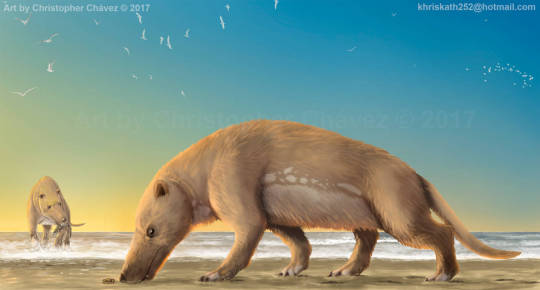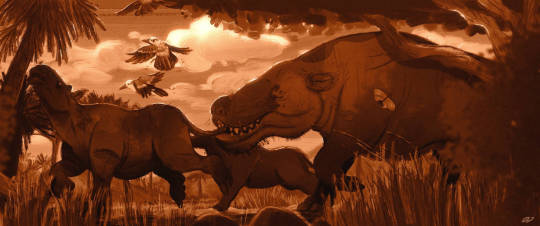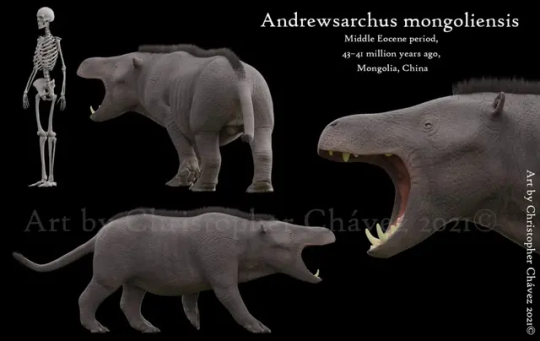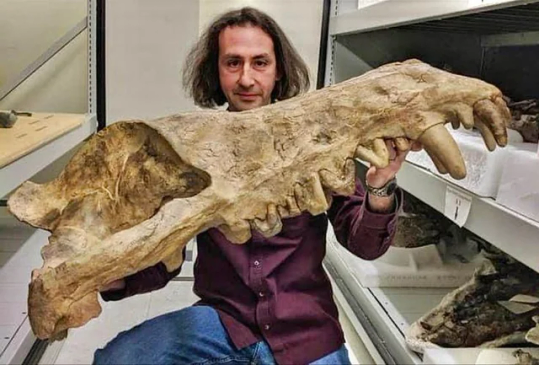#mesonyx
Explore tagged Tumblr posts
Text

Woah a 4th page?? Yeah Ive got a problem
#paleo pines#paleopines#dinosaur#marine reptile#fish#shark#pterosaur#mammal#arthropod#trilobite#dakosaurus#plesiosaurus#ichthyosaurus#dunkleosteus#megalodon#tylosaurus#hatzegopteryx#quetzalcoatlus#utahceratops#lokiceratops#eohippus#mesonyx#smilodon#elasmosaurus#miacis#andrewsarchus#art#my art
175 notes
·
View notes
Text

“In the course of twenty million years, mammals got more and more successful until they were the biggest, fiercest, and most spectacular animals on the planet. Whatever the climate, whatever the habitat, mammals made it their own. Their great strength was their ability to adapt. They grew to gigantic sizes, they evolved into powerful killers like the famous sabre-tooth cats, and they even laid claim to the oceans.”
- Kenneth Branagh, prologue to “Walking with Beasts”
Sketches of some of the incredible wildlife of the Cenozoic Era. None of the animals are exactly shown to scale. From left to right, bottom to top:
Arctocyon, Barylambda, Coryphodon, Titanoboa
Uintatherium, Notharctus, Mesonyx, Eobasileus
Leptictidium, Gastornis, Propaleotherium, Titanomyra, Godinotia, Pakicetus, Ambulocetus
Apidium, Arsinotitherium, Andrewsarchus, Embolotherium, Moeritherium, Dorudon, Basilosaurus, Perucetus
Megacerops, Cainotherium, Merycoidodon
Cynodictis, Paraceratherium, Hyaenodon gigas, Chalicotherium, Paraentelodon
Gentilicamelus, Amphicyon, Daeodon, Moropus, Dinocrocuta, Platybelodon, Gomphotherium, Pelagornis, Purussasaurus, Odobenoceratops, Otodus megalodon
Phoruschracos, Astrapotherium, Teleoceras, Synthetoceras, Samotherium, Livyatan
Australopithecus afarensis, Deinotherium, Ancylotherium, Dinofelis
Mammuthus columbi, Smilodon fatalis, Bison latifrons, Aenocyon dirus, Arctodus simus, Panthera atrox, Titanotylopus, Equus hersternus, Sivatherium, Gigantopithecus, Paleoloxodon
Smilodon populator, Macrauchenia, Doedicurus, Megatherium, Glyptodon, Toxodon
Mammuthus primigenius, Megaloceros giganteus, Coelodonta antiquitatis, Bos primigenius, Homo neanderthalensis, Elasmotherium, Bison bonasus
#paleoart#paleontology#cenozoic mammal#cenozoic animals#cenozoic mammals#cenozoic era#cenozoology#cenozoic#palaeontology#paleoartist#artists on tumblr#paleoartists on tumblr#paleoblr#paleogene#neogene#quaternary#paleocene#eocene#oligocene#miocene#pliocene#pleistocene#palaeoart#paleo#palaeoblr#paleoillustration
61 notes
·
View notes
Text
I have vague and conflicting notes about an OC being a beastformer based on "hoofed carnivores" but I have not a goddamn clue which I meant so I'm just going to. Smash Mesonyx (real but extinct) and the Mares of Diomedes (mythological) together and see where I go from there
#sorry for oc stuff#I was going to change Arion's name but ykw I'm going to stick with it#as it's another reference to a mythological horse#...which I got from the PJO books I was reading at the time#I thought I lost most/all of my notes for this au but I found some cached away in a weird place#and ik I definitely didn't intend for it but here_ Arion reads more like someone PRETENDING to be an ex-decepticon#rather than //actually// having defected from the decepticon faction#which I've decided is a far more juicy story than my initial idea#oc#tf oc#arion#new-old colony au#my ocs
7 notes
·
View notes
Text










Andrewsarchus is an extinct genus of artiodactyl that lived during the Middle Eocene in what is now Asia some 47 to 37 mya. The holotype consisting of a nearly complete 2.75ft (84cm) skull was recovered from the lower Irdin Manha Formation of Inner Mongolia by Kan Chuen-pao aka “Buckshot” during a 1923 palaeontological expedition conducted by the American Museum of Natural History of New York. It was initially identified by Walter W. Granger as the skull of an Entelodon. A drawing of the skull was sent to the museum, where it was identified by William Diller Matthew as belonging to "the primitive Creodonta of the family Mesonychidae". The specimen itself arrived at the museum and was described by Henry Fairfield Osborn in 1924. Its generic name honours Roy Chapman Andrews, the leader of the expedition, with the Ancient Greek archos meaning ruler added to his surname. In the 1957, Zhou Mingzhen and colleagues recovered a mandible, a fragmentary maxilla, and several isolated teeth from the Lushi Formation of Henan, China, which correlates to the Irdin Manha Formation. Zhou described it in 1959 as Paratriisodon henanensis, and assigned it to Arctocyonidae. In 1978 Paratriisodon was synonymised with Andrewsarchus by Leigh Van Valen. A second species of Andrewsarchus, A. crassum, was named by Ding Suyin and colleagues in 1977 from a pair of teeth recovered from the Dongjun Formation of Guangxi. Andrewsarchus was initially regarded as a mesonychid, and Paratriisodon as an arctocyonid. In 1995, the former became the sole member of its own subfamily, Andrewsarchinae, within Mesonychia. It has since been recovered as a more basal member of Cetancodontamorpha, most closely related to entelodonts, hippos, and whales. When first describing Andrewsarchus, Osborn based on the length of the A. mongoliensis holotype skull, and using the proportions of Mesonyx, estimated the animal to be 12.5ft (3.82m) long and 6.2ft (1.89m) tall, making andrewsarchus the largest terrestrial carnivorous mammal to ever live. However, considering cranial and dental similarities with entelodonts, Frederick Szalay and Stephen Jay Gould proposed that it had proportions less like mesonychids and more like entelodonts, and estimated andrewsarchus would have reached around 10.5ft (3.2m) long, 4.6ft (1.4m) tall, and 1760 (800kgs) in weight.
Art Utilized can be found at the following links below
#pleistocene pride#pliestocene pride#cenozoic#eocene#prehistoric animals#andrewsarchus#extinct animals#animal facts
2 notes
·
View notes
Text
𝑯𝒆𝒓𝒆 𝒈𝒐𝒆𝒔 𝒏𝒐𝒕𝒉𝒊𝒏𝒈 ✧˖°.⟡ ━ Hello tumblr, I'm an artist known as Miss Mesonyx dipping her toes in the chaotic tumblr waters in hopes of a new start after a long hiatus, and stepping way outside her comfort zone in doing so.
I can't promise I'm not anxious, but I can promise if you like magical, mystical & mythological themes, astrology, astronomy, and beautiful detailed things to look at, you might just like my blog.
Thank you for considering joining me on this magical adventure by sending a follow my way, and have a lovely day! 🩷❤️ ✧˖°.⟡
#artists on tumblr#art#artwork#astrology#astronomy#greek mythology#roman mythology#digital art#traditional art#anti ai#anti generative ai
3 notes
·
View notes
Note
Next letter for Demoman, Heavy, and Engineer:
Favorite non-dinosaur prehistoric dinosaur?
Demoman: Oh, now that's a good one. Hard to pick..
Engineer: Well.. suppose if I had to pick, probably the Glyptodon. I grew up in an area that had a lotta armadillos in it. I think those lil things are adorable.
Demoman: They are cute, ain't they? I'd probably hafta go with the Mesonyx. Wot about you Heavy?
Heavy: Saber-toothed Tiger.
Demoman: Suits you, I'd say.
13 notes
·
View notes
Text

The Rise of Mammals. Written by Roy A. Gallant. 1986. Illustration by Charles Knight (1874-1953)
Internet Archive
125 notes
·
View notes
Text
Xixit - PA142
Today we're listening to excellent tunes from a really great DOS "Columns" clone called Xixit - PA142 @neoj1n
On the surface, Xixit is a pretty straightforward Columns clone. Go a little bit deeper and you find a columns clone with impressive coding, visual effects and music. Xixit was released for DOS in 1995 by Optik Software, a small American publisher that only ever released 3 games, the other two being a point and click called Igor and an RTS called War Inc. The gameplay is your typical match three…

View On WordPress
#Andrew Sega#Andrew Wise#c.c.catch#Jon Dal Kristbjornsson#Jon Hood#Kenny Chow#mesonyx#necros#nemesis#oman#Optik Software#Thomas Pytel#tran#Xixit
0 notes
Photo







The prehistoric animal designs I did for people at Toyhouse.
#anurognathus#mosasaurus#mesonyx#chalicotherium#pteranodon#triceratops#velociraptor#Brittany's doodles
20 notes
·
View notes
Photo

random007 . #art #artwork #artist #animals #drawing#draw #gingmaliwan #illust #illustration #mesonyx #procreate https://www.instagram.com/p/CCGtDmVDtnj/?igshid=1uuwawjd5pvon
0 notes
Text
It Came From The Wastebasket #20: Colossally Convoluted Condylarths
"Insectivora" was a wastebasket taxon so bad it had to be revised multiple times, but there's another particularly infamous case in mammal taxonomy that's still in the process of being resolved – the "condylarths".
This group was first created in the early 1880s, during the Bone Wars, and initially was just a subgroup of odd-toed ungulates containing only the phenacodontids. But just a few years later Condylarthra was promoted up to its own order, and groups like the periptychids and hyopsodontids were added in too.
Then over the next few decades various groups were added and removed from the condylarths, most notably with the mesonychids and arctocyonids being brought in from their previous position with the creodonts.
By the mid-20th century the condylarths had become a big convenient dumping ground for any and all "primitive" ungulate-like mammals that didn't easily fit into any modern groups, ranging in age from the early Paleocene through to the early Oligocene. But it soon became apparent that they had the same problem as the "insectivores" – there weren't really any unique anatomical features that united all these animals together.
They generally had rounded-cusped molar teeth and hoof-like toes, but they also had rather generalized "primitive mammal" features and a diverse range of ecologies. Some were small herbivores, but others were coati-like or dog-like omnivores, and some were even bear-sized carnivores.

From left to right, top row: Hyopsodus lepidus (hyopsodontid), Meniscotherium chamense (phenacodontid), Arctocyon primaevus ("arctocyonid"). Bottom row: Ectoconus ditrigonus (periptychid), Mesonyx obtusidens (mesonychid)
It wasn't even clear how the various different condylarth groups were actually related to each other. The best guess was that arctocyonids had arisen from within the "insectivores", with a Protungulatum-like form as the common ancestor of all the other condylarths. Where exactly modern ungulates had then evolved from within the condylarths was also still uncertain.

This looks familiar (Image sources: http://hdl.handle.net/2246/358 & https://knowyourmeme.com/memes/pepe-silvia)
Cladistic analysis in the 1980s began to tackle the confusing pile of assorted condylarths, and showed that they weren't the single ancestral source of all modern ungulates, but instead a loose collection of several unrelated groups from all over the ungulate evolutionary tree. Arctocyonids, periptychids, and hyopsodontids were placed as early "primitive" lineages, phenacodontids were loosely linked with the ancestors of odd-toed ungulates once again, and mesonychids were considered to be the ancestors of whales.

…And if you know modern mammal phylogeny you'll probably see some big problems here. 🐘 (Image source: https://doi.org/10.1017/S2475263000001343)
And, once again paralleling the mess of the "insectivores", it wasn't until genetic methods became available in the late 1990s that larger-scale ungulate relationships began to be properly resolved. The paenungulates (elephants, hyraxes, and sirenians), which had been traditionally considered to be a major branch of ungulates, were removed entirely and reclassified as afrotheres. And, along with some new fossil discoveries, whales were recognized as having actually evolved from within the even-toed ungulates instead of from mesonychids.
This shake-up threw the still-problematic "condylarth" classifications back into question – with some "condylarths" turning out to also be afrotheres instead of true ungulates.
Today the actual relationships of the main "condylarth" ungulate families are still in the process of being figured out, and there's a lot of remaining uncertainty and disagreement about them.
Phenacodontids seem to have mostly maintained their traditional position as early odd-toed ungulates, and hyopsodontids may potentially be part of this group too – possibly as members of the hippomorph lineage, closely related to horses and brontotheres. Arctocyonids might be a wastebasket themselves, with some studies finding them to be a mix of several different archaic ungulate lineages. Periptychids may have links to the even-toed ungulates. The mesonychids, meanwhile, are now generally considered to be a separate order from the traditional "condylarths", and may be either an early branch of the even-toed ungulates or much more basal ungulates closely related to the "arctocyonids".
Since the term "condylarth" no longer has any real taxonomic meaning some paleontologists have proposed replacing it with "archaic ungulate" to distance from the historical messiness of the old name. But this hasn't really caught on, and many papers still use "condylarth" in a very loose sense to refer to an "evolutionary grade" of early ungulates of unclear evolutionary affinities.

———
And while that's the last main entry for this month, we're not quite done yet. There's still one weekday left in October, and after digging through so many taxonomic garbage cans there's only one place we can go now.
…See you in the trash heap.
———
Nix Illustration | Tumblr | Twitter | Patreon
#it came from the wastebasket#wastebasket taxon#taxonomy#condylarths#ungulate#mammal#paleontology#art#science illustration#paleoart#palaeoblr
206 notes
·
View notes
Text
Jellicles as Dinosaurs*
(*More accurately, the prehistoric animal each Jellicle would be) (NOTE: Pretty much none of these animals would've occupied the same timeline/environment/circumstances as each other, but this is just for fun - and yes, I know it doesn't make sense to have carnivores and herbivores in the same herd, but just assume the carnivores find other sources of food at any oases the herd comes across on their migration)
Alonzo: Achilloraptor - Big raptor that used to run with Macavity but now protects the herd. Is subservient to Munkustrap.
Asparagus Jr: Polacanthus - Doesn't do all that much, follows the herd pretty contently.
Bombalurina: Dinofelis - Sleeker than other saber-cats. Capable hunter that has a coalition with Demeter.
Bustopher Jones: Muttaburrasaurus - Big, hungry, a bit lumbery but can run pretty fast when he decides to skedaddle.
Cassandra: Ornithomimus - Sleek, quick, a little neurotic. Runs ahead to scout out future paths.
Coricopat and Tantomile: Parasaurolophus - Mysterious, have a really iconic look together with their head crests, they do a lot of stargazing.
Demeter: Smilodon - Less sleek as Bomba, but just as powerful, if not even more so.
Electra: Sinonyx - Little bitey creature. Weaves around the herd and tries not to get stepped on.
Etcetera: Mesonyx - Another little bitey creature. Chases Electra and plays with her a lot.
Exotica: Saurolophus - Dignified, does a lot of lounging in the shade with the other older girls.
George: Andrewsarchus - BIG bitey creature. Is tentatively given permission to follow the herd, but doesn't often show intentions of predation on them. Likes to play with the raptors and thinks he is one.
Grizabella: Gobihadros - Old lady who's doing her best. Falls behind a lot and has scars from Macavity.
Gus: Placereas - Fucking ancient. Old as shit. How is he even keeping up with everyone else?
Jellylorum: Oviraptor - A very good carer and broodmother.
Jemima: Leaellynasaura - Smal but smart and perceptive, quick on her feet.
Jennyanydots: Maiasaura - An equally dedicated caregiver, just a bit larger.
Macavity: Allosaurus - Biggest predator around, constantly following the herd.
Mr Mistoffelees: Ornitholestes - Devious, clever, spends most of his time on the edges of the herd nipping at rodents.
Mungojerrie: Carnotaurus - Big lad, sometimes runs with the herd, but also sometimes runs with Macavity. Munk doesn't really trust him but he's never attacked a herd member before.
Munkustrap: Mantellisaurus - Will absolutely slice you up with his thumb spikes if you try to get close to his herd. Makes accommodations for peaceful predators who want to join during drought migrations.
Old Deuteronomy: Gigantopithecus - Wise old monkey man, doesn't lead the herd but somehow appears at every oasis they visit.
Plato: Deinonychus - The biggest of the younger raptors. Totally didn't fall in love with an iguanodont during the migration.
Pouncival: Velociraptor - The smallest of the younger raptors. Looks up to Alonzo and Mungojerrie. Isn't great at hunting.
Rum Tum Tugger: Megantereon - Saber-cat with the biggest sabers. Powerful but prefers to not do any of the hard work. Follows Bomba's coalition around and mooches off their kills.
Rumpleteazer: Majungasaurus - Hangs around with Jerrie since they're both abelisaurids. They squabble a lot and Teazer has to vouch for Jerrie's promises not to hunt the herd.
Skimbleshanks: Megaloceros - Scottish Irish Elk. Noble, keeps an eye out for the herd, but doesn't mingle often.
Tumblebrutus: Dromaeosaurus - The mid-sized member of the younger raptors. Is pretty boistrous and nips at other herd members sometimes. A little dubious, could grow up to be a serious threat.
Victoria: Uteodon - Smaller iguanodont. May or may not have fallen in love with a raptor.
#cats the musical#paleontology#dinosaurs#hc#au#NO ONE is gona care about this other than me so let me live okay?#I'm sick today you guys have to be kind to me and that means no laughing at my headcanons
30 notes
·
View notes
Note
What I found on the 1rst page of Googgle about Greek names for planets.
Astra Planeta (Αστρα Πλανητα / Astra Planêta); "Wandering Stars", "Planets" the Stellae Errantae)
//In Greco-Roman Classical Mythology, the Astra Planeta are brothers, and are five of Eos' and Astraeus' children, along with the Anemoi and Astraea, personifying the Classical planets (minus the Sun and the Moon (Eos' siblings), and the Earth (Gaia)). Uranus, Neptune and Pluto are not included, as they are invisible to the naked eye and were thus unknown to the ancient Hellenic peoples. //
There is an interesting thing that you should know to understand why I include this information here. In my research on Boiling Isles, there was some kind of celestial war between "Titans" and "Star people" deityies. Both sides have a religeous cults dedicated to them. Most of the followers are witches.
Since witches that steal human teeth are from Mars then it means they serve "star people" and therefore the "Titans" cult is their opposite. Maybe we could find some temporary alligment with "tolerable" witches that oppose this sky alien race. (But the Titan look like litteral Satan so that is questionable.)
Mercury
// Original name is stilbon (Στίλβων). In the ancient Greek religion it is the sky god of Hermaon and one of the Astra Planeta. The word, Stilbon, means shining. //
The name sounds like "stillborn" missing "l" and "r". Maybe we could get a date out of this.. L = 12 (!!!), R = 18. I have 0 ideas.
Venus
// Hesperus (/ˈhɛspərəs/; Ἕσπερος, Hésperos) is the Evening Star, the planet Venus in the evening. Hesperus' Roman equivalent is Vesper ("evening", "supper", "evening star", "west"). Also called Εωσφόρος / Φωσφορος //
Dont see anything in particular yet.. I see only "Herpies" and "Hes-per-us" aka "He is per us"
Mars
//Pyroeis (Πυρόεις) in ancient Greek religion is the god of the wandering star (Aster Planetos / Astra Planeta) Areios. He is also known as Mesonyx (Μεσονυξ; "midnight").//
Bonus: I see Me-sony-x hidden message. The company is definetly connected to demons-! Maybe it is the one sending the teeth on Mars using teleportation tech. Or magic even.
Saturn
// Phaethon (Φαέθων), means "radiant" (from the verb φαέθω, meaning "to shine"). This name could be understood as, "the shining/radiant (one)". Ultimately the word derives from φάος, phaos, the Greek word for light. Phaethon, also spelled Phaëthon. //
I think the easiest connection we can find is to Photons.. but the truth cant be that overly simple. Phaos sounds like chaos, Phaethon sounds like Python (Pythonidae). So what I am taking from this is that Saturn is a capital for Lisard people Empire. And they could be behind the egyptian pyramids. Probably they hyde a good amount of radiation inside of them, that was prodused by the mummies.
--Your №1 Fan
BUT OF COURSE......... IT ALL MAKES SENSE.
THIS WHOLE TIME. THE ENTIRE SOLAR SYSTEM HAS BEEN APART OF THIS.
NASA IS LYING TO US AND THIS IS OUR PROOF.
You're absolutely right. Of course, the rings on saturn are the roads satelliates for communication from lizards to demons.
The pyramids... the radiation.... mummy energy... WE'RE CRACKIN THIS THING WIDE OPEN.
4 notes
·
View notes
Photo





Edward Drinker Cope – Scientist of the Day
Edward Drinker Cope, an American paleontologist, was born July 28, 1840.
(read more...)
#Edward Drinker Cope#Othniel Marsh#extinct mammals#Eobasileus Mesonyx#fossils#histsci#19th century#history of science#Ashworth#Scientist of the Day
72 notes
·
View notes
Text

𝑴𝒆𝒔 • 𝒐𝒏𝒚𝒙 ; Midnight Star – Astra Planeta of the fiery wandering star of Ares and Herakles, ruling passion & energy.
𝑰𝒎𝒑𝒐𝒓𝒕𝒂𝒏𝒕 𝑰𝒏𝒇𝒐 & 𝑫𝒊𝒔𝒄𝒍𝒂𝒊𝒎𝒆𝒓𝒔:
Miss Mesonyx (Mesonyx), She / Her artist & novice astrologer on the Autism Spectrum just trying to do her best and share her creations.
Please DNI if you support hate of any kind or support generative AI of any kind.
Please do not copy, steal, trace my artwork or insert it into any AI generators. This goes for the characters of my own creation featured in my artwork as well.
Reblogs of my work are always appreciated (honestly beloved lol), however I can not stress enough how reposting my work is not. – Without going into the deep of it, sharing my work online isn't easy for me. This blog is my way of trying to be brave about creating and sharing what I create again, but I need to take the steps in doing so at my own pace. Thank you for understanding, and being an amazing human being by respecting all of these guidelines, but this one especially in particular.
𝑨𝒓𝒕 𝑰𝒏𝒇𝒐:
4 art showcases & hopefully counting ❤️
Initial sketches done traditionally with good ol' pencil, paper & the occasional use of prismacolor pencils. I then color, shade, and all that jazz using photoshops lovely paint brush tool. No AI or art tablet involved, just a nice logitech computer mouse bc I'm woefully tech inept and stuck in my ways. (But I am looking to switch over to clip studio paint in the future)
Most of the characters featured in my work are either characters of my own creation who will be featured in a series I'm working on bts, or Deities of Greek & Latin mythology.
Commissions status: Closed – Giclée prints status: Unavailable - please look forward to them ❤️

0 notes
Photo

(Note: I am not a professional paleontologist or even biologist. I am just and amateur paleoartist and enthusiast. If my infos are off in some way, feel free to correct them ^^)
-
DINOCEMBER
19 - Gastornis parisiensis (from Greek "Gaston Platé's Bird") - Paleocene to Eocene (56-45 Ma BCE) - Northern Hemisphere
At the beginning of the Paleogene, until end of the Eocene, the Earth went through an intense greenhouse effect, being virtually without ice for 200,000 years in an event known as "Paleocene-Eocene thermal maximum", covering the entire planet in tropical forests and with an average temperature 8ºC hotter than today. During this period, the birds, the only dinosaurs that survived the mass extinction to the end of the Cretaceous (66 Ma BCE), began to diversify with more intensity, occupying several vacant niches, in the same way as mammals, which would become the new "owners of the world". Before that, however, several families of birds reigned, as members of the genus Gastornis, present in Europe, China and North America. A peculiar member of the superorder Galloanserae, which includes pheasants, turkeys, peacocks, chickens, ducks and geese, present since the end of the Cretaceous, Gastornis was a large terrestrial, flightless bird, with an extremely robust body constitution, reaching up to about 2 meters in height and weighing up to 200 kg, being in many locations the largest animal present in the local fauna, which indicates that it could be virtually without predators, taking into account the size of the carnivorous mammals found in the same formations, such as Mesonyx, that was the size of a German shepherd. For a long time it was believed that the Gastornis themselves were the apex predators of their food chains, using their powerful beaks to attack small mammals in the same way that the Terror Birds did in South America. More recent studies, however, indicate that these birds were probably herbivores, without large, predator-like claws on their feet, and using their beaks to open hard seeds and fruits. Probably the replacement of forests by mosaics from open prairies and woodlands at the end of the Eocene, with sudden drops in temperature, must have contributed to the extinction of this Avian dinosaur, a relic of an older time even in its own time of existence.
- Color scheme inspired bi a Victoria Crowned Pigeon (Goura victoria) and Liam’s version.
#dinocember#dinocembere2020#gastornis#paleocene#eocene#cenozoic#big birb#terror duck#paleobiology#paleontology#paleoart#paleoillustration#Science illustration#sciart#avian dinosaur#feathered dinosaurs#paleogene#creature art#creature design#creature concept#Digital Artists#digital art#digital drawing#artists on tumblr
9 notes
·
View notes